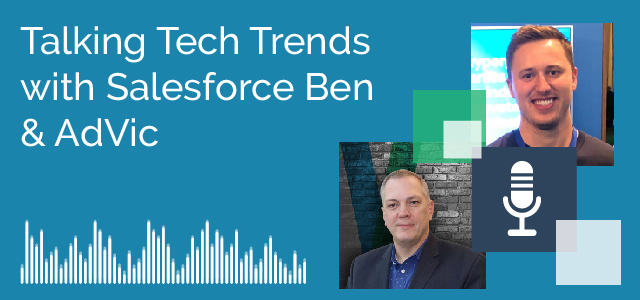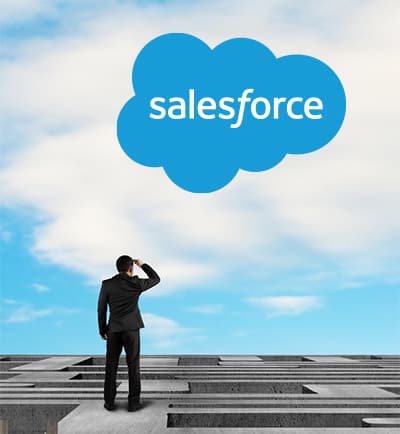Talking Tech Trends with Salesforce Ben & AdVic
Estimated reading time: 5 minutes
In the world of technology, things are ever-changing. From automation, updates, and discoveries, there are constant advancements to benefit businesses across all industries.
During a recent AdVic® “Salesforce Simplified” podcast – titled “Talking Tech Trends with Salesforce Ben” and featuring Salesforce Ben’s Ben McCarthy and AdVic President Brian Mize – we discussed top tech trends that may impact the industry and business practices in the near future.
AI (Artificial Intelligence) in 2022
When the pandemic swept in over two years ago, there was an influx in the use of AI, not only in the Salesforce® world, but through the technology space. AI has been a huge benefit to organizations, as it caters to employees and customers alike. For employees, it provides the flexibility to work remotely. For customers, AI provides personalized experiences, and it provides insights to businesses that allow them to make actionable and better decisions that improves the overall quality of their business.
Artificial intelligence is integrated into all of Salesforce’s clouds, meaning no matter the industry, vertical, or business size, there is a cloud that can provide business intelligence that satisfies customer expectations.
“AI, at the end of the day, people still aren’t fully comfortable with it for a number of reasons. They want to know that they have a person on the other end, and I think with what Salesforce is doing with AI, and bots, and a number of other avenues, they’re still able to deliver that.” – Brian Mize
AR (Augmented Reality) and VR (Virtual Reality)
Although the Metaverse is still in development with AR and VR, Meta Platforms (Facebook’s parent company) will be pushing it in the near future. If their predictions are accurate, we may see this coming into remote work life and frequent meetings as it offers more of a personable experience.
“If the Metaverse does happen, instead of Google Meets, instead of Zooms, we could be having VR-, AR-type meetings in the Metaverse where we’re walking around, we’re shaking hands with people, and talking to people with really good graphics that makes it seem like real life.” – Ben McCarthy
Cybersecurity
As AI continues to transform and businesses rely more and more on data, many organizations have made an intentional effort to protect their cybersecurity investments and customer data. Whether it be data breaches or cyberattacks, businesses are persistent in maintaining their technology against cyber threats.
During the podcast, AdVic’s Brian Mize talked about data laws and how they differ from place to place. “We have borderlines that data can’t cross from one country to another, one geo to another.” This gives customers the confidence that the data that they are sharing is protected.
Salesforce Shield™ offers many ways to protect data. A couple are multi-factor authentication, and making sure that you can lock down access to your systems where they are, these are all designed to take measures to enhance cybersecurity, making sure that your data is safe wherever it is a huge piece in a cyber security strategy.
“As AI continues to increase, so will cybersecurity because, again, you have more data, you have more data flowing back and forth, which gives more potential for data breaches, more potential for exploiting weaknesses and systems. These two things are going to grow together as we look into the future.” -Brian Mize
Low- to No-Code
Low- to No-code allows marketers, customer service reps, human resources, and other end-users to add automation, fields, and other customizations to their tech without using code. With low-code capabilities, non-developers are empowered to customize apps with drag and drop functionality or point and click.
Salesforce Ben’s Ben McCarthy describes Low- to No-Code as an “exciting feature, especially in the Salesforce world as they are phasing out workflow rules and process build or automation tools in favor of flow.” He predicts that a substantial amount of code in the future will be done with declarative low-code/no-code tools, and that can accelerate development times and reduce the need for expensive developers.
One of the most popular products that provides this is MuleSoft’s Composer, which connects apps and data quickly and easily with clicks, not code.
“I think a huge amount of development could be done using declarative, no-code/low-code tools,” – Ben McCarthy
Distributed Cloud Computing
Distributed Cloud Computing is the ability to take computing needs, resources, and storage cycles, and distribute them across a broad region of public and private clouds. In essence, it’s getting data close to the end-users so the internet can function and scale for businesses and users alike.
“As we look ahead, Salesforce takes advantage and offers some edge computing, certainly some distributed cloud. And the goal of it all is to take the data, to take the processing, to take the need, and get it as close to the end user as it can be so that you have faster response time, and you have quicker throughput on what you need.” – Brain Mize
Not sure if your business can benefit from these trends, or already know it can? Let’s discuss your thoughts, we’ll share our experiences, and we’ll make a plan that is best for your business. And we can start as early as today!
Related Resources
Talking Tech Trends with Salesforce Ben (Podcast)


